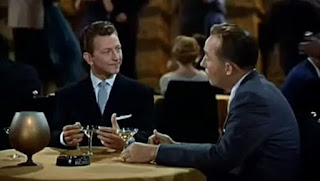 |
The plot of White Christmas went through several permutations before Danny Kaye joined the project.
Although Bing Crosby was necessarily attached to White Christmas from its conception, co-star Danny Kaye was a last-minute addition. He was called in days before filming was to begin to replace the ailing Donald O’Connor. O’Connor himself had also been a replacement—for Fred Astaire.
The project originated in 1952, with Paramount’s desire for a sequel to their 1942 hit Holiday Inn to be named after the picture’s hit song, “White Christmas.” Holiday Inn’s stars, Crosby and Astaire, and composer, Irving Berlin, showed interest. Berlin even had a time-saving idea for the story: “White Christmas” had skyrocketed up the charts to become the number-one single ever recorded, with much of its popularity attributed to how much the tune meant to soldiers off at war.
Four years earlier, Berlin and playwright Norman Krasna had created a stage musical, Stars on My Shoulders, that was to be produced by Rogers and Hammerstein. Its plot focused on the post-war life of a retired general who—feeling forgotten—considers running for president, and is given a boost by his former soldiers.
Krasna went to work trying to recraft Stars on My Shoulders as a vehicle for Crosby and Astaire that would feature “White Christmas” as the title song. It didn’t have to play like a true sequel to Holiday Inn, but was to at least harken back to it.
Krasna’s first script, dated September 29, 1952, featured the “well-known song-and-dance team” partners Chuck (Crosby) and Johnny (Astaire). They are longtime friends, who have a friendly rivalry over women—though Johnny is more the playboy, Chuck the protective watchdog.
They are appearing in the elaborate revue Fancy Free in Miami, and decide to close the show until after the holidays. At a roadside diner, they meet Helen O’Conner and her kid sister, Judy. The boys are both taken with Judy, amusing Helen, who’s used to seeing men fall all over her sister. The girls, also performers, are finishing up a local engagement and have another booking lined up in Pine Tree, Vermont. But the girls have been unable to pay their hotel bill, and the proprietor is holding their trunk.
Chuck and Johnny hatch a scheme to switch trunks and send the girl’s luggage to Vermont, COD. They then go to watch the O’Conner Sisters perform, where they spot the sheriff in the audience, waiting for girls to finish. During intermission, the boys don the girls’ outfits, and the girls escape to the railroad station. After Chuck and Johnny perform the girl’s number, they’re stopped by the sheriff—who lets them go, because he’s an old Army pal. The boys then join up with the girls on the train, and they all head off to Vermont.
The inn where the sisters are to appear is owned by the boys’ former Army superior, General Waverly. Unfortunately, the inn has few guests, because there’s no snow. So, to drum up a crowd, Chuck and Johnny offer to bring in their Fancy Free company, since they’re “not doing anything,” and put Helen and Judy in the act.
The whole time, Helen is secretly miserable because she’s falling for Chuck, who she thinks still likes Judy. But Judy has actually been hitting it off with Johnny. Finally, Helen heads to New York to work as a solo act. The General, misreading the situation, tries to console Chuck by telling him Helen left because she liked Johnny.
Chuck is now more worried about the General. He’s now lost a lead singer and there’s still no snow. General Waverly says not to worry, because he has a letter coming that will make everything okay. Soon after, the letter does arrive, but it’s not the news the General was hoping to hear. The Army has declined the General’s request to be reinstated, explaining that he’s “too old.” Chuck intercepts the news, and heads to New York—first to ask Helen to return, and second to ask a favor of another old Army buddy, radio/TV gossip columnist Steve King. On his next broadcast, King shares the plight of the forgotten “old man” and encourages anyone who served under Waverly to support his inn. The show opens on Christmas to a packed house of Army veterans, bringing the General to tears. And as the leads sing “White Christmas,” it begins to snow.
 |
The original plan was to capitalize on the popularity of the song “White Christmas” by reuniting Bing Crosby with Fred Astaire, his co-star in Holiday Inn, in which he introduced the song. |
Ultimately, Astaire backed out. The scenario had to be tweaked after his role was given to the younger Donald O’Connor and after Crosby demanded that his character not act too young or frivolously. (Even the characters’ names were changed. The producers suggested Chuck should be the more practical Robert, Bob or James; Johnny should be the more naive Phillip; Helen the less stodgy Betty or Beth; Steve King be the newsier Ed or Walter; and Fancy Free become Heads Up.)
Kaye’s arrival led to further changes, to better fit Kaye’s more comical image and to give work to Kaye collaborators Norman Panama and Mel Frank.
 |
Although Donald O’Connor had to drop out of White Christmas at the eleventh hour, Paramount teamed him with Crosby two years later as song-and-dance men in Anything Goes. |
In the end, White Christmas would retain three of the nine songs Berlin wrote for Stars on My Shoulders: “(We’ll Follow) the Old Man,” “What Can You Do with a General?” and “Monohan & Callahan” (which was rewritten as “A Singer – A Dancer” when Donald O’Connor was cast, and then re-rewritten as “A Crooner – A Comic” when Kaye signed on).
Despite all the permutations, White Christmas has become a beloved holiday classic that most of us could not imagine any other way.

No comments:
Post a Comment